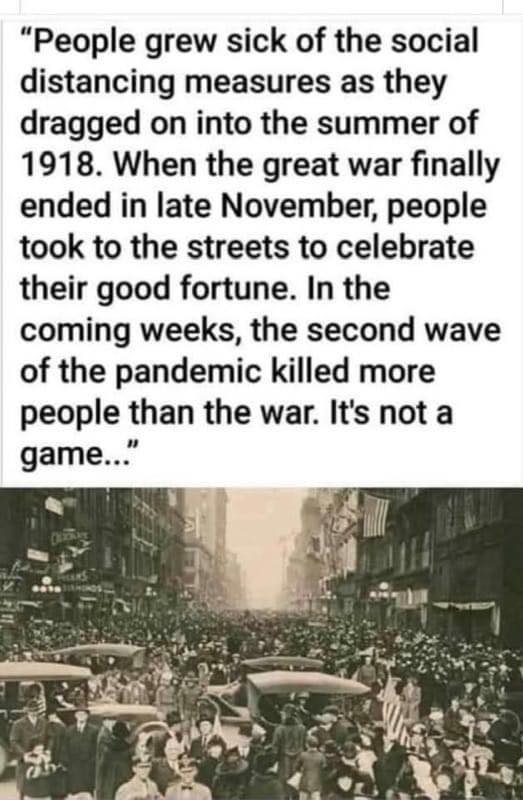kalm wrote: ↑Mon Apr 20, 2020 4:02 pm
GannonFan wrote: ↑Mon Apr 20, 2020 2:19 pm
On the first point, what would "strategic industry and domestic" for medical supply chain and manufacturing even look like? Sounds great, but the execution and details are pretty key. Knowing that you have the right "things" nationalized and domestic for whatever pandemic is coming down the road is the gamble. And even then do you have all the right things planned?
As for the second point, if it can start now, why don't we do that now? The answers will be the same 2 months from now, but we'll have 2 more months of economic misery to go through until then. 20M-30M unemployed people, at a minimum, is terrible. I know for some folks this isolation is just a bunch of binge watching on multiple streaming platforms or trying to cope with kids in the house 24/7, but for too many people it's desperation of where is the next meal coming from and how can I stay in my house kind of anxiety. My family hasn't had our income affected by this yet (and really we've made money as the kids netted me $500 each in the last relief package), but obviously many families are. We owe it to them to have a good reason why they need to wait 1-2 months to get back to work when they could do it now with the same restrictions now that they'll have in place 1-2 months from now when they do get back to work. What is the 1-2 months of economic misery buying us? I don't see those answers out there.
All fair points.
Here’s one of what I hope are many opening salvos into the economics that will inform rational decision making:
“But the dollars and cents of a virus are less intuitive. Rebelo uses a modified version of what’s known as an SIR model, an acronym for categories of people: susceptible, infected, and recovered. It simulates how a disease moves through a population based on how infectious and lethal it is, and how much contact people have with each other. To put a price on the results, Rebelo takes the number of predicted deaths and calculates an economic estimate of the value of the lost lives. The approach is similar to the price that the U.S. Environmental Protection Agency used to gauge the costs and benefits of environmental regulations: $9.5 million per life.
His initial modeling efforts showed that even a yearlong lockdown makes economic sense, to allow time for a vaccine to be developed. The pause would shrink the economy by approximately 22%—a cost of $4.2 trillion. By comparison, the model shows that without containment measures, the economy would contract by about 7% over that year—but as many as 500,000 additional lives would be lost, which translates into a loss of roughly $6.1 trillion.
Andrew Atkeson, an economist at the University of California, Los Angeles, agrees that the economics point strongly toward strict measures. If the epidemic is allowed to grow unhindered, he predicts the economy will grind to a halt anyway as people see an explosion of infections and stop going out. “Either you shut off the economy now and have people staying at home, or you let this thing rip and you have people staying at home scared,” he says.“
https://www.sciencemag.org/news/2020/03 ... e-covid-19#
They need to estimate how many lives will be lost as a result of the lockdown.
Economists are also weighing subtler interactions between health and economics, including the possibility that the economic shock itself will add to the body count. Public health experts broadly agree that more suicides happen in recessions. Scientists found an additional 4750 suicides in the United States over 3 years attributable to the Great Recession of 2008. Trump pointed to a potential increase in suicides as a reason for loosening restrictions.
Yet economic downturns have typically translated into a net drop in deaths, says Christopher Ruhm, an economist at the University of Virginia who has studied the phenomenon. Although suicides can rise, decreased economic activity can save lives partly because it reduces traffic accidents and air pollution, he says.
There are notable exceptions. Death rates rose in Russia following the collapse of the Soviet Union, because the economic downturn was part of a broader social collapse, Ruhm says. In the case of the coronavirus pandemic, Ruhm says it’s too soon to know, but “my guess would be purely from the economic aspect there would be some modest decline in mortality.”
I think Ruhm is looking at this too simplistically. This might not be comparable to the collapse of the Soviet Union but it has the potential to be much more significant than the Recession of 2008. Plus deaths and damage due to the lockdown won't be just suicides. We will have deaths from:
- People losing their jobs and access to healthcare
- Malnutrition, poor eating and limited ability to exercise
- Alcoholism, addiction, etc.
- Increased abuse
- Increased homelessness
- I'm sure there are others that I'm not thinking of at this moment
I'm interested to see what happens in a city like Chicago where gang violence spikes during the hot summer months. Will shelter-in-place save lives or will tempers rise even higher and deaths with them?
The other economic consideration is how much money can the government throw at people to keep food in their bellies and a roof over their head. At some point do we print so much money that we become the Weimar Republic?
This is an extremely complicated situation and there are no simple answers. Lock everything down until we have a vaccine is just as simplistic and short-sighted as open everything back up right now.











